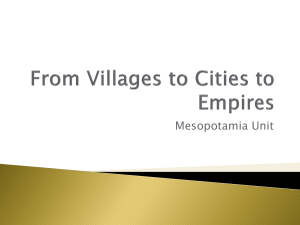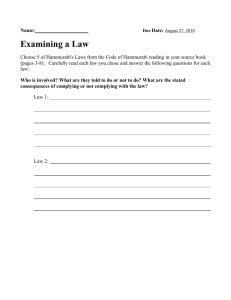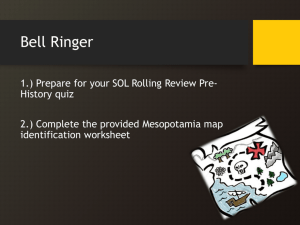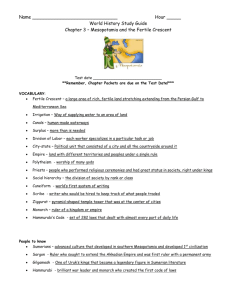Mesopotamia ppt
advertisement
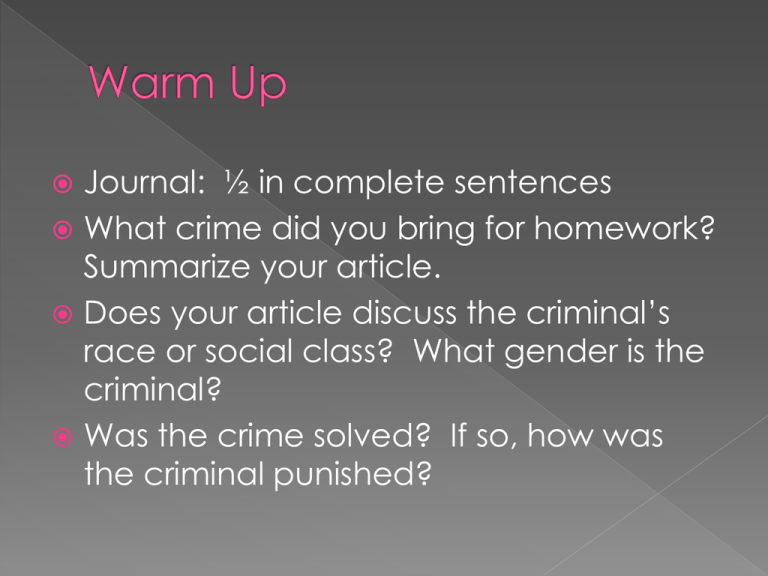
Journal: ½ in complete sentences What crime did you bring for homework? Summarize your article. Does your article discuss the criminal’s race or social class? What gender is the criminal? Was the crime solved? If so, how was the criminal punished? Turn to page 44 in your textbook. Read Hammurabi’s code. Think-Pair-Share- What is Hammurabi’s code like as a set of laws? Fair or unfair? Why? Write 3 sentences explaining how the crime your article describes would be handled under Hammurabi’s Code. Think about these questions: › How would the criminal be punished under American laws? › How do you think the criminal would be punished in Mesopotamia (based on the code you read)? › Is the criminal considered to be in a “lower” social group? If so, how would this change their punishment? Think- Pair-Share Why did all of the river valley civilizations form around rivers? The fertile crescent was between the Tigris and Euphrates rivers. The land was extremely good for growing crops. The rivers would flood which would enrich the soil. The flooding was random, and people could never tell how big the floods would be. Irrigation- the people controlled the floods with drainage ditches and used them to water their crops. Sumerians founded Mesopotamia. Assyria and Akkadians came after. Mesopotamia had many cities. › Eridu › Ur › Uruk • These cities had economic and political control over the surrounding countryside. Uruk was surrounded by a six mile wall with 30 foot defense towers. Mud was used to make sun-dried bricks. The bricks were used to make homes, city buildings and ziggurats. Some of these buildings are still around today! Temples made with mud brick that had large steps. People believed that gods and goddesses owned the cities. The government was a theocracy (government ruled by divine authority) The ziggurats were the political, religious, and economic capitals of the cities. The kings’ power came from the gods. The kings had powerful armies and lived in large palaces. Mostly farming, but trade was important too. Industry was important. › Metalwork › Wool clothes › Pottery • They invented the wheel which made trade much easier. Nobles- Priests and royals Commoners- 90% of population › Farmers, merchants, artisans • Slaves- Worked for royals and priests • Society was patriarchal (dominated by men) Polytheistic Gods were not kind or reliable. This was believed because of famine, hot climate and random flooding. Hammurabi was Babylonian › Hammurabi’s code Strict justice system 282 laws Upper class criminals were punished less than lower class criminals. Women had fewer rights than men. Most laws focused on marriage and family. “an eye for an eye” Sumerians invented cuneform writing. Used a stylus to carve writing on clay tablets. Epic of Gilgamesh- first epic poem! Empire- Large political unit or state, usually under a single leader, that controls many peoples or territories. Theocracy- Government by divine authority. Patriarchal- A society dominated by men. Polytheism- belief in many gods. In the 3rd section of your spiral define the following words for Unit 1: › › › › › › › › › › Agriculture Paleolithic Civilization Domestication Nomadic Monarchy Oligarchy Dynasty Bureaucracy Monotheism Research Stonehenge. Write a 1 page paper about it. Provide 2 sources! Egypt – page 45 India -page 71-79 China- 88-97
